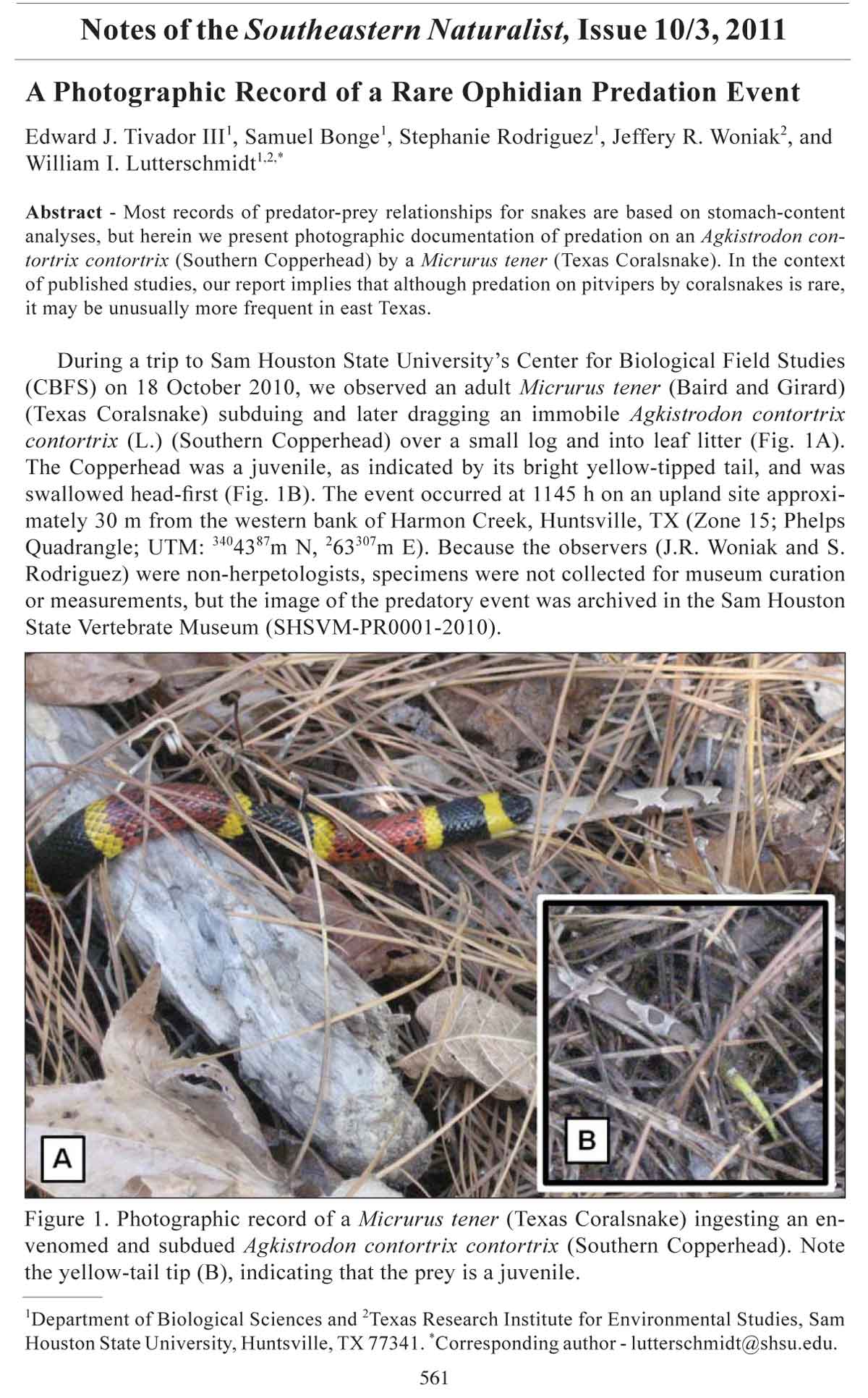A Photographic Record of a Rare Ophidian Predation Event
Edward J. Tivador III1, Samuel Bonge1, Stephanie Rodriguez1, Jeffery R. Woniak2, and
William I. Lutterschmidt1,2,*
Abstract - Most records of predator-prey relationships for snakes are based on stomach-content
analyses, but herein we present photographic documentation of predation on an Agkistrodon contortrix
contortrix (Southern Copperhead) by a Micrurus tener (Texas Coralsnake). In the context
of published studies, our report implies that although predation on pitvipers by coralsnakes is rare,
it may be unusually more frequent in east Texas.
During a trip to Sam Houston State University’s Center for Biological Field Studies
(CBFS) on 18 October 2010, we observed an adult Micrurus tener (Baird and Girard)
(Texas Coralsnake) subduing and later dragging an immobile Agkistrodon contortrix
contortrix (L.) (Southern Copperhead) over a small log and into leaf litter (Fig. 1A).
The Copperhead was a juvenile, as indicated by its bright yellow-tipped tail, and was
swallowed head-first (Fig. 1B). The event occurred at 1145 h on an upland site approximately
30 m from the western bank of Harmon Creek, Huntsville, TX (Zone 15; Phelps
Quadrangle; UTM: 3404387m N, 263307m E). Because the observers (J.R. Woniak and S.
Rodriguez) were non-herpetologists, specimens were not collected for museum curation
or measurements, but the image of the predatory event was archived in the Sam Houston
State Vertebrate Museum (SHSVM-PR0001-2010).
1Department of Biological Sciences and 2Texas Research Institute for Environmental Studies, Sam
Houston State University, Huntsville, TX 77341. *Corresponding author - lutterschmidt@shsu.edu.
Notes of the Southeastern Nat u ral ist, Issue 10/3, 2011
561
Figure 1. Photographic record of a Micrurus tener (Texas Coralsnake) ingesting an envenomed
and subdued Agkistrodon contortrix contortrix (Southern Copperhead). Note
the yellow-tail tip (B), indicating that the prey is a juvenile.
562 Southeastern Naturalist Vol. 10, No. 3
The vast majority of knowledge on snake diets is based on stomach-content analyses,
and predation is rarely photographically documented in nature (Greene 1984, Jackson and
Franz 1981, Symondson 2002). The fossorial nature of the Texas Coralsnake further contributes
to a lack of ecological observations on the species, with almost all current dietary
information indeed being based upon stomach-content analyses (Curtis 1952, da Silva
and Aird 2001, Greene 1984, Jackson and Franz 1981, Schmidt 1932). Coralsnakes feed
primarily on other snakes and slender-bodied lizards, with previous analyses reporting
species of the families Colubridae (sensu lato), Elapidae, Viperidae, Anguidae, Amphisbaenidae,
and Scincidae in the diet (Curtis 1952, Greene 1984, Jackson and Franz 1981,
Polis and Myers 1985). Whereas Coralsnakes frequently engage in ophiophagy (Maffei et
al. 2009, Schmidt 1932) and even cannibalism (Curtis 1952), stomach contents from 106
Texas Coralsnakes revealed only two incidences of predation on Southern Copperheads
(Greene 1984). These two records were from east Texas (Greene 1984), and no pitvipers
were found in stomachs of Texas Coralsnakes from north-central, central, and south
Texas. Texas Coralsnake is restricted to upland deciduous woodlands (Ford et al. 1991),
which is also the primary habitat of sympatric Southern Copperhead at the CBFS.
Our record is of further interest because prey preference is the most important determinant
of venom composition in Micrurus spp. (da Silva and Aird 2001), and snake venom
composition sometimes varies geographically within a species (Daltry et al. 1996).
The presence of Southern Copperheads in the stomachs of Texas Coralsnakes only from
east Texas may thus reflect local prey preferences, so studies of geographic variation in
venom constituents may be of future interest.
Acknowledgments. We acknowledge the funding of collaborative research between the
Colleges of Arts and Sciences and Criminal Justice that serendipitously made possible
this natural history report. We thank the editorial staff and reviewers for their helpful
comments, and the Center for Biological Field Studies for the opportunity to conduct
related field research.
Literature Cited
Curtis, L. 1952. Cannibalism in the Texas Coral Snake. Herpetologica 8:27.
Daltry, J.C., W. Wüster, and R.S. Thorpe. 1996. Diet and snake venom evolution. Nature 379:537–540.
da Silva, N.J., Jr., and S.D. Aird. 2001. Prey specificity, comparative lethality, and compositional
differences of coral snake venoms. Comparative Biochemistry and Physiology Part C
128:425–456.
Ford, N.B., V.A. Cobb, and J. Stout. 1991. Species diversity and seasonal abundance of snakes in a
mixed pine-hardwood forest of eastern Texas. Southwestern Naturalist 36:171–177.
Greene, H.W. 1984. Feeding behavior and diet of the Eastern Coral Snake, Micrurus fulvius. Pp.
147–161, In R.A. Seigel, L.E. Hunt, J.L. Knight, L. Malaret, and N.L. Zuschlag (Eds.). Vertebrate
Ecology and Systematics: A Tribute to Henry S. Fitch. Museum of Natural History. The
University of Kansas, Lawrence, KS. 278 pp.
Jackson, D.R., and R. Franz. 1981. Ecology of the Eastern Coral Snake (Micrurus fulvius) in northern
peninsular Florida. Herpetologica 37:213–228.
Maffei, F., G.R. do Nascimento, and D.G. Neto. 2009. Predation on the lizard Ameiva ameiva (Sauria:
Teiidae) by a coral snake Micrurus frontalis (Serpentes: Elapidae) in Brazil. Herpetology
Notes 2:235–237.
Polis, G.A., and C.A. Myers. 1985. A survey of intraspecific predation among reptiles and amphibians.
Journal of Herpetology 19:99–107.
Schmidt, K.P. 1932. Stomach contents of some American coral snakes, with the description of a
new species of Geophis. Copeia 1932:6–9.
Symondson, W.O.C. 2002. Molecular identification of prey in predator diets. Molecular Ecology
11:627–641.













 The Southeastern Naturalist is a peer-reviewed journal that covers all aspects of natural history within the southeastern United States. We welcome research articles, summary review papers, and observational notes.
The Southeastern Naturalist is a peer-reviewed journal that covers all aspects of natural history within the southeastern United States. We welcome research articles, summary review papers, and observational notes.